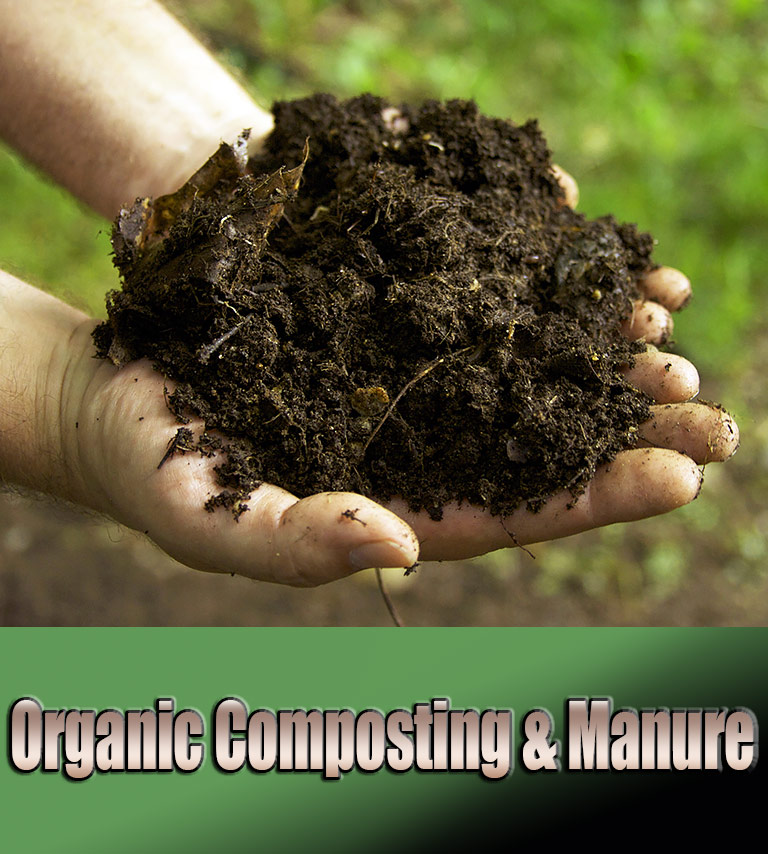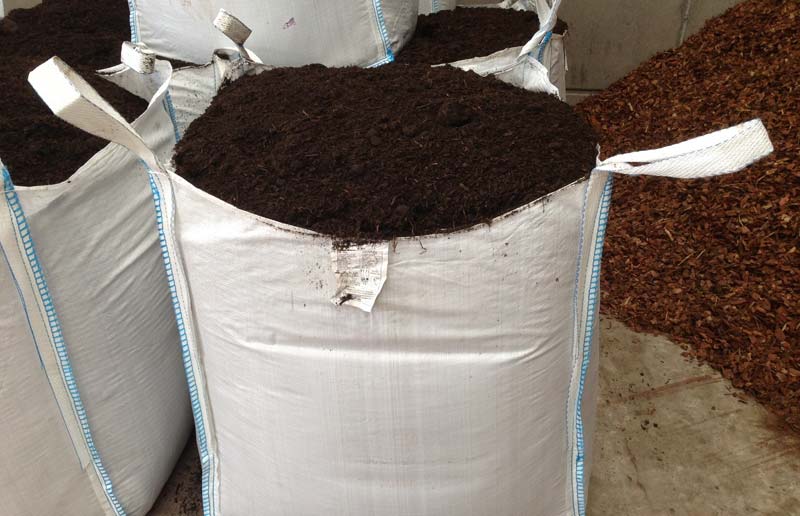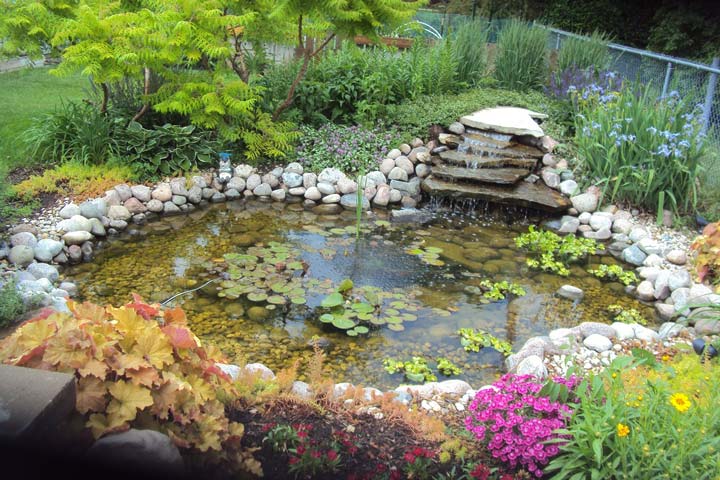
Organic Composting & Manure
Bulky Manures
Garden compost, well-rotted animal manure and bulky organic materials such as spent mushroom compost usually only add small amounts of fertiliser to your garden. They are, however, invaluable in improving the structure of the soil, its water-holding capacity and the ability of the soil to retain nutrients applied from other sources. Obtaining bulky manures in built-up areas can be difficult and potentially smelly. If you’ve got a small house and garden you won’t get many bonus points by having a large smelly heap of horse manure dumped outside the front door. My dad tried that one once. Not a popular move!
You can do quite a lot though, even in a small area, by making your own compost. It also helps with disposal of grass cuttings, vegetable peelings and garden waste that may, otherwise, be put into the ordinary dustbin. This waste of resources isn’t so bad if your local council provides ‘green bins’ for garden clippings and cardboard. Sadly, too many councils don’t provide this service. Our council has its own compost-making plant and they recycle vast amounts for use in the local area. Some councils sell the compost back to residents for a very reasonable fee, or even give it away if you transport it yourself.
DIY Compost & Bins
It’s almost impossible to have too much garden compost, so make as much as you can. It doesn’t go far when you spread it out later. You can form a compost heap without a container, but if you want your heap to look tidy it’s best to buy a bin or make one from wood. Again, before forking out on an expensive bin at a garden centre, enquire with the local council. Many have special offers to encourage new homeowners. Some provide free wormeries as well. Our daughter found a very cheap compost bin on the internet quite recently, at a fraction of the list price. We’ve used all sorts of containers over the years, as you can’t easily take the bin with you when you move house, so have tried old dustbins, large kitchen waste bins, leaky water butts, random heaps and home-made wooden bins.
We’ve also got a free ‘dalek’ style bin from the council, which is brilliant. The advantage of this one is that the base is wider than the top, so you can easily lift the whole bin off the heap for redistribution. You can re-site it easily after emptying, if you find a better position, or you want to improve another bit of garden which it stands on. The leaky water butt has the disadvantage of a rim inside the base, where we cut the bottom off. This one has to be turned on its side and encouraged to ‘give generously’ with a spade or fork. Heavy work! Some of the others we’ve tried have hatches at the bottom, but they get clogged up with compost, as do box constructions, where you’re supposed to fork out the compost by removing the bottom slats. Wooden boxes can be bought as flat-pack kits, or made out of pallets and bits and pieces.
Recipe for Compost
- Stand the bin on a level surface where it can rest undisturbed.
- To provide aeration, place twiggy material at the bottom of the heap, then pile on kitchen and garden refuse that will rot down easily. You can add outer leaves, peelings from fruit and vegetables as well as grass cuttings.
- Don’t put thick prunings in or woody material unless shredded first.
- If you have large amounts of one type of material, such as lawn mowings, add them in layers about 15 cm (6 in) deep, with other material between. Firm down loose material and dampen dry material after adding to the pile.
- Fill the bin to the top, then cover with a layer of soil, put on the lid if you have one, or cover until the ingredients look like soil. This will take from three to eight months, depending on the temperature. Ideally, if you have room it’s worth having two bins – one to fill and one to leave to rot down. This way you are not tempted to add to the heap that is nearly ready to use.
Tips for Quick Compost
- Use a bin as large as possible – this generates more heat and increases the chance of the material rotting down more quickly.
- Keep material moist and be prepared to water in dry weather if necessary.
- Cover the top in wet weather to prevent waterlogging. Let in plenty of air at the base or sides.
- In winter cover with an old carpet or similar cover to keep it warm. Compost takes longer to mature in cold weather.
- Speed up the rotting process by turning over after a few weeks, then putting back the outside material in the middle.
Leaf Mould
If you have large, mature deciduous trees around your garden, or in neighbouring areas, you’ll probably have mixed feelings when the leaves blow all over your garden. The vast bulk of rotting leaves can be a real pain, blowing around in the autumn. As fast as you’ve cleared the lawns and paths, the wretched things are back again. If they fall on the lawn, you must clear them, otherwise the leaves will damage the grass as they decay and encourage bacteria that you don’t want. On paths they can become very slippery, even though the family might think it’s good to shuffle around in them, kicking them all over the place. If they fall on flower beds there is the possibility of encouraging slugs and snails to overwinter at your expense, and also of course, to kill the plants as they rot. There’s nothing more frustrating on a windy day than raking leaves into piles, turning round to get a bag to collect them in and seeing them disappear in all directions. Far better to wait until the wind drops.
Technology & Tools
You may be the sort who would rather try a machine for collecting leaves, but don’t bother splashing out on a leaf blower/vacuum. It is quite good fun blowing the leaves all over the place but they still need picking up. The model we tried only seems to like sucking up certain types of leaves, and doesn’t like them wet at all. This is a major setback in autumn weather, and given the quantities of leaves we clear every year, completely unworkable. A rake is all you need to collect the leaves and then you can turn this annual job into a valuable organic addition to the enrichment of the soil. You can hold the leaves in some netting, supported by posts, although getting the leaf mould out after two years can be a bit tricky. A friend, who hates collecting leaves almost as much as he hates weeding, has come up with a much more satisfying solution:
Leave it to Crane Bags
If you’ve had any sand or ballast delivered by lorry, you may have a crane bag or two to spare. These can be really useful for a variety of purposes, but the best uses we’ve found are as collectors of leaves and bins for making leaf mould. We use crane bags, each held in place by four posts driven into the ground to support the looped handles. Make sure there are holes in the bottom. When you want to move them you can, with some help, drag the bags to where you want to deposit the leaf mould. Don’t be tempted to put leaves in with your compost because they are more fibrous and decompose at different rates. Oak and beech leaves take up to two years to decompose. Others take less time. When the leaves have formed a crumbly, rich, soil-like consistency, use them as a mulch on bare ground or dig into the top layer of soil, where it will improve the structure.
Ideally you will have-a row of three bags to use for different years. As the leaves take rather a long time you won’t have to mix different ‘vintages’ and will always have a bag available for collecting the new leaf fall in October. Because they are so light and deep, crane bags make the ideal container to collect the leaves in the first place, especially if it’s windy and you have some help to hold the bag open. On your own there might be a problem as you need at least three hands! An alternative to crane bags, especially for smaller quantities, is a supply of black plastic sacks which you can fill and leave in a corner somewhere, out of sight, to rot down.
Green Manure
A green manure crop is a plant grown mainly to enrich the soil. It is a very old method of soil improvement and often has the added bonus of keeping down weeds as well. Green manure is grown on a bare piece of land, allowed to reach a certain stage, then is dug directly back into the soil. The disadvantage of this method in a small garden is fairly obvious, but there are a variety of plants which can be used to benefit other plants or crops. On a large parcel of land grazing rye can be used, sown between September and November. As it grows it uses nutrients which would otherwise be washed out by rain throughout the winter and also blocks other weeds from growing. In the spring the plants can be dug back into the soil. The root systems of the plants can be huge, but as rye is an annual it won’t become a weed. The roots will improve the structure of clay soil.
MUSTARD is a more popular, fast-growing plant that can be used for green manure. You can sow it between crops from May to August and it is ready to dig in after four to six weeks. Mustard adds nitrogen to the soil, rather than improving soil structure.
COMFREY has deep roots and large leaves. If growing well the leaves can be harvested four times a year. There are various ways of using these leaves as instant fertiliser.
- Cut the leaves and leave to wilt for two days. When you dig a trench for potatoes or runner beans, put a 5 cm (2 in) layer in the bottom before planting. You can also put them under tomatoes.
- Use them as a mulch between vegetables, and around tomatoes and soft fruits which need high levels of potash, e.g. redcurrants, raspberries.
- Make a liquid feed by putting the comfrey leaves in a bucket, barrel or butt. Weigh the leaves down to press them, and after a few weeks the liquid can be drained off for growing vegetables, diluted one to ten.
- Add leaves to your existing compost bin.
Recycling Lawn Turfs
If you’ve decided that you don’t want all that lawn when you can grow much more interesting plants or delicious vegetables instead, don’t just throw the turfs away or kill them with chemicals. Skim off the top 5 cm (2 in) and pile them up in pairs like sandwiches, green sides inwards. Cover with black polythene and store in a quiet corner for the winter. By the following year the grass should have died off and you will have gained some brilliant top soil to add to beds, or to use in containers as compost. You will have saved money on weedkiller and made a lot of worms and other animals and insects very happy in their winter home. We’ve even had newts move into ours, from the pond. This is another way of giving something back, instead of always taking from the soil bank, and you help our friends, the worms, as well.





This is exactly the information I wanted. Thank you. Can you please add/send more pictures of the setup and anything related to get a clearer picture. Thank you once again 🙂